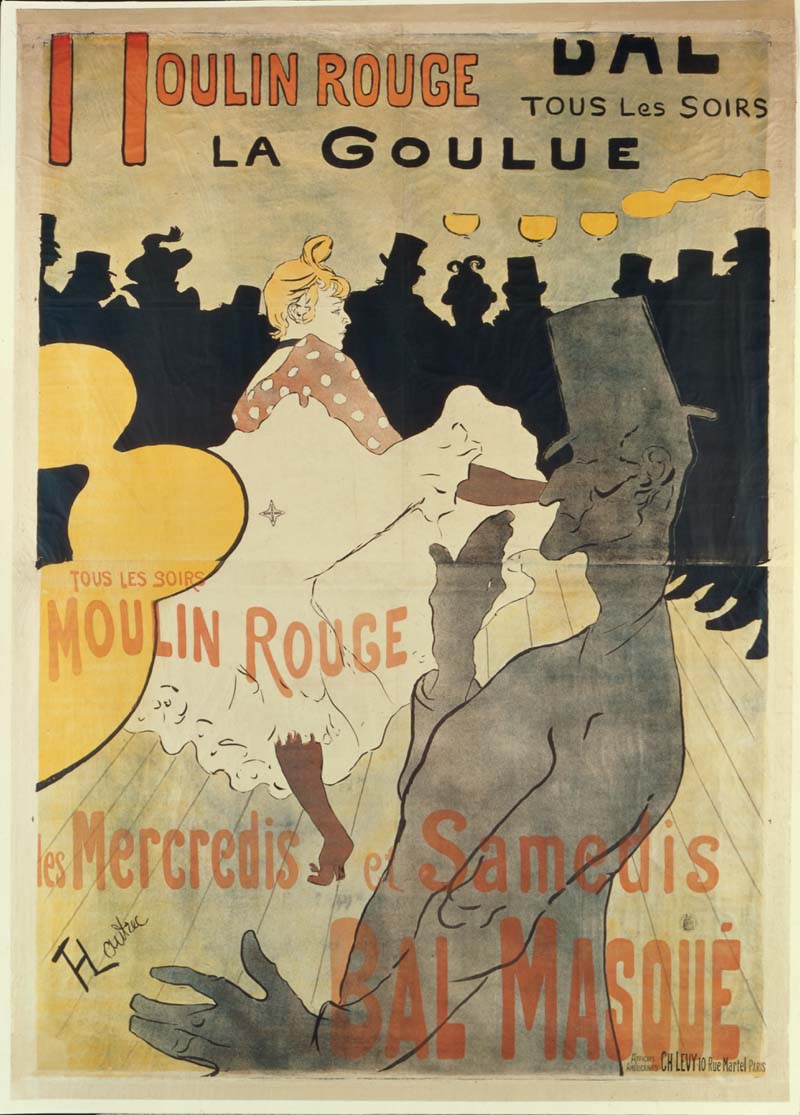February 15, 2004
Toulouse-Lautrec: Master of the Moulin Rouge Opens at the BMA

Famous posters celebrate bohemian nightlife of 1890s Paris
BALTIMORE, MD (February 15, 2004)—Henri de Toulouse-Lautrec became a sensation overnight when his first poster of a dancer performing the cancan hit the streets of Paris. Today, the artist’s bold use of color and unique perspective distinguish his posters as masterpieces. Toulouse-Lautrec: Master of the Moulin Rouge, on display at The Baltimore Museum of Art from February 15 through May 23, 2004, features more than 100 rarely seen posters and prints by the artist and his contemporaries, including Pierre Bonnard and Édouard Vuillard. These legendary works of art range from posters of raucous scenes in Parisian cabarets and groundbreaking advertisements for 19th-century products to fine lithographic prints made just for collectors.
Virtually all of Toulouse-Lautrec’s celebrated posters of Parisian dance halls and cabarets–and the characters who filled them—are featured in this special ticketed exhibition. Tickets include an Acoustiguide audio tour that will bring the exciting world of Toulouse-Lautrec and Paris’ Belle Époque to life in the galleries.
“The Museum’s 90th Anniversary in 2004 launches an exciting year of BMA-organized ticketed shows that will attract visitors from Baltimore and beyond,” said BMA Director Doreen Bolger. “People will be dazzled by the vibrant color and large scale of Toulouse-Lautrec’s vintage lithographs, all drawn from the BMA’s outstanding collection of 19th-century French prints.”
A patron of Paris’ infamous Moulin Rouge music hall, Toulouse-Lautrec defined Parisian life of the 1890s with his images. The galleries will be populated by colorful characters who kept Toulouse-Lautrec company, such as cancan dancer Jane Avril and the audacious cabaret singer with the signature red scarf, Aristide Bruant. The exhibition also features period poster advertisements by Toulouse-Lautrec and others, including a classic art nouveau poster for Job cigarettes by Alphonse Mucha and Théophile Alexandre Steinlen’s charming poster for sterilized milk featuring his daughter Colette with a trio of hungry cats.
On rare view is a series of 10 intimate scenes of ladies of the evening during quiet moments of their day as they loosen their hair, sleep, and awaken. The series, called “Elles” (“Those Women”), did not sell well in the 1890s, but it is now considered one of the greatest examples of print lithography, as well as one of the most important print portfolios. Also featured are rarely seen advertisements for print portfolios, novels, and avant-garde magazines such as La Revue blanche, a periodical that published lithographs by many of the artists in the exhibition. Several posters will also be exhibited in different states―with and without lettering, for example―as well as authentic lithographic stones and tools, so that visitors can better understand the elaborate printmaking process.
The BMA has one of the most important collections of late 19th-century French prints in the country, with particularly strong holdings in the work of Toulouse-Lautrec and Édouard Manet and American expatriates Mary Cassatt and James Abbott McNeill Whistler. Other notable artists represented in this collection include Edgar Degas, Paul Cézanne, Pierre Bonnard, and Édouard Vuillard.
Toulouse-Lautrec: Master of the Moulin Rouge is organized by The Baltimore Museum of Art and curated by Susan Dackerman, BMA Curator of Prints, Drawings & Photographs.
This exhibition is generously sponsored by Wilmington Trust.
Additional support is provided by The Print & Drawing Society of The Baltimore Museum of Art.
Henri de Toulouse-Lautrec (1864-1901)
One of the most fascinating and distinctive figures of French 19th-century art, Toulouse-Lautrec is recognized as the first artist to truly embrace the possibilities of commercial imagery and production. His masterful work with lithography raised the art poster to its highest level of achievement and elevated advertising to an art form. Toulouse-Lautrec was born to the highly aristocratic family of the Counts of Toulouse. A physical malady of controversial diagnosis left him of short stature and limited mobility. Unable to participate in his father’s occupations of hunting and riding, he developed his boyhood pastime of sketching into a productive career as an artist. In Paris the young artist pursued the pleasures and performers of the cabarets and dance halls by night, and painted in his Montmartre studio by day. By the time of his death at age 36, he had finished over 1,000 paintings, drawings, and lithographs―a panoramic view of popular culture in the Paris of the 1890s.
About the Baltimore Museum of Art
Founded in 1914, the Baltimore Museum of Art (BMA) inspires people of all ages and backgrounds through exhibitions, programs, and collections that tell an expansive story of art—challenging long-held narratives and embracing new voices. Our outstanding collection of more than 97,000 objects spans many eras and cultures and includes the world’s largest public holding of works by Henri Matisse; one of the nation’s finest collections of prints, drawings, and photographs; and a rapidly growing number of works by contemporary artists of diverse backgrounds. The museum is also distinguished by a neoclassical building designed by American architect John Russell Pope and two beautifully landscaped gardens featuring an array of modern and contemporary sculpture. The BMA is located three miles north of the Inner Harbor, adjacent to the main campus of Johns Hopkins University, and has a community branch at Lexington Market. General admission is free so that everyone can enjoy the power of art.
Press Contacts
For media in Baltimore:
Anne Brown
Baltimore Museum of Art
Senior Director of Communications
abrown@artbma.org
410-274-9907
Sarah Pedroni
Baltimore Museum of Art
Communications Manager
spedroni@artbma.org
410-428-4668
Alina Sumajin
PAVE Communications
alina@paveconsult.com
646-369-2050